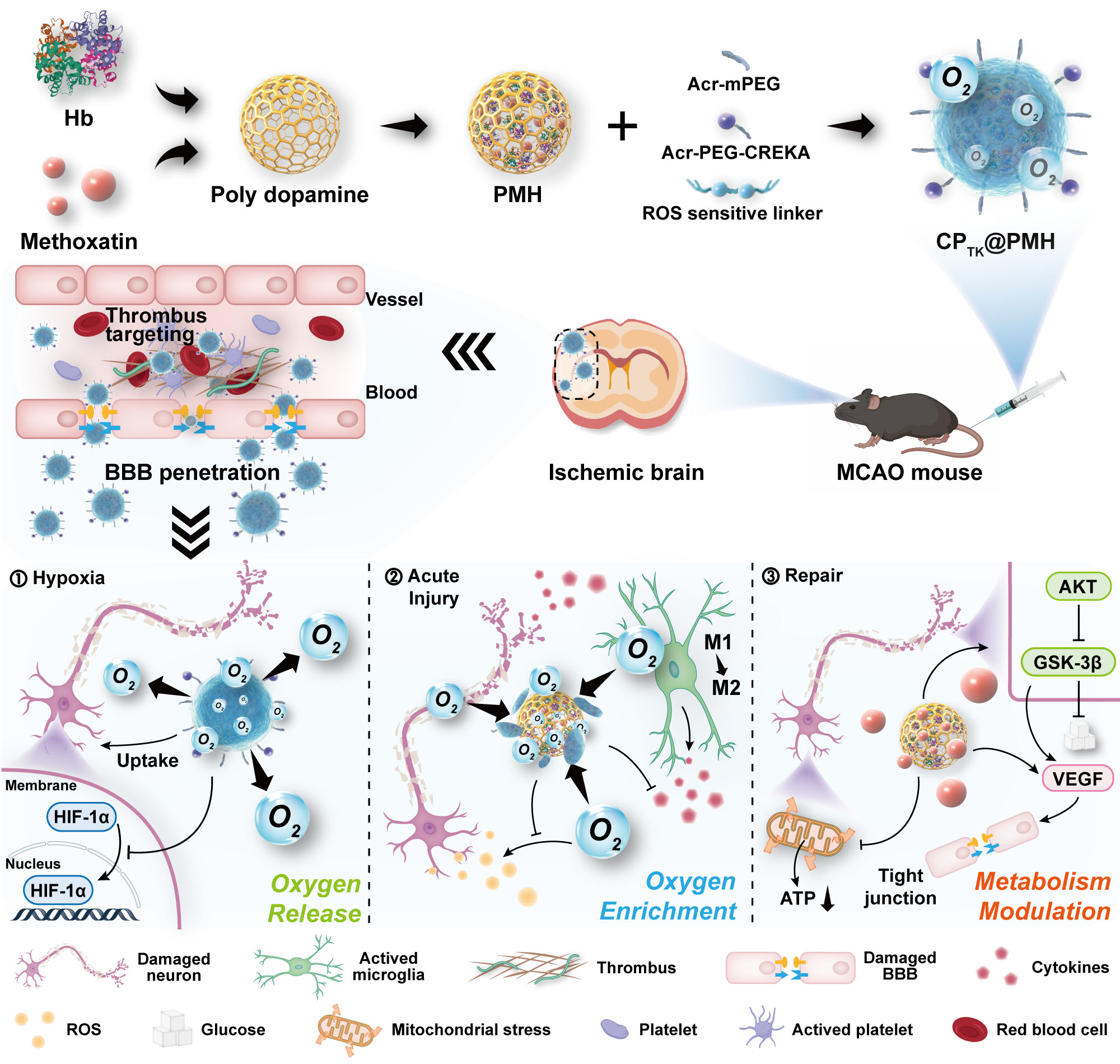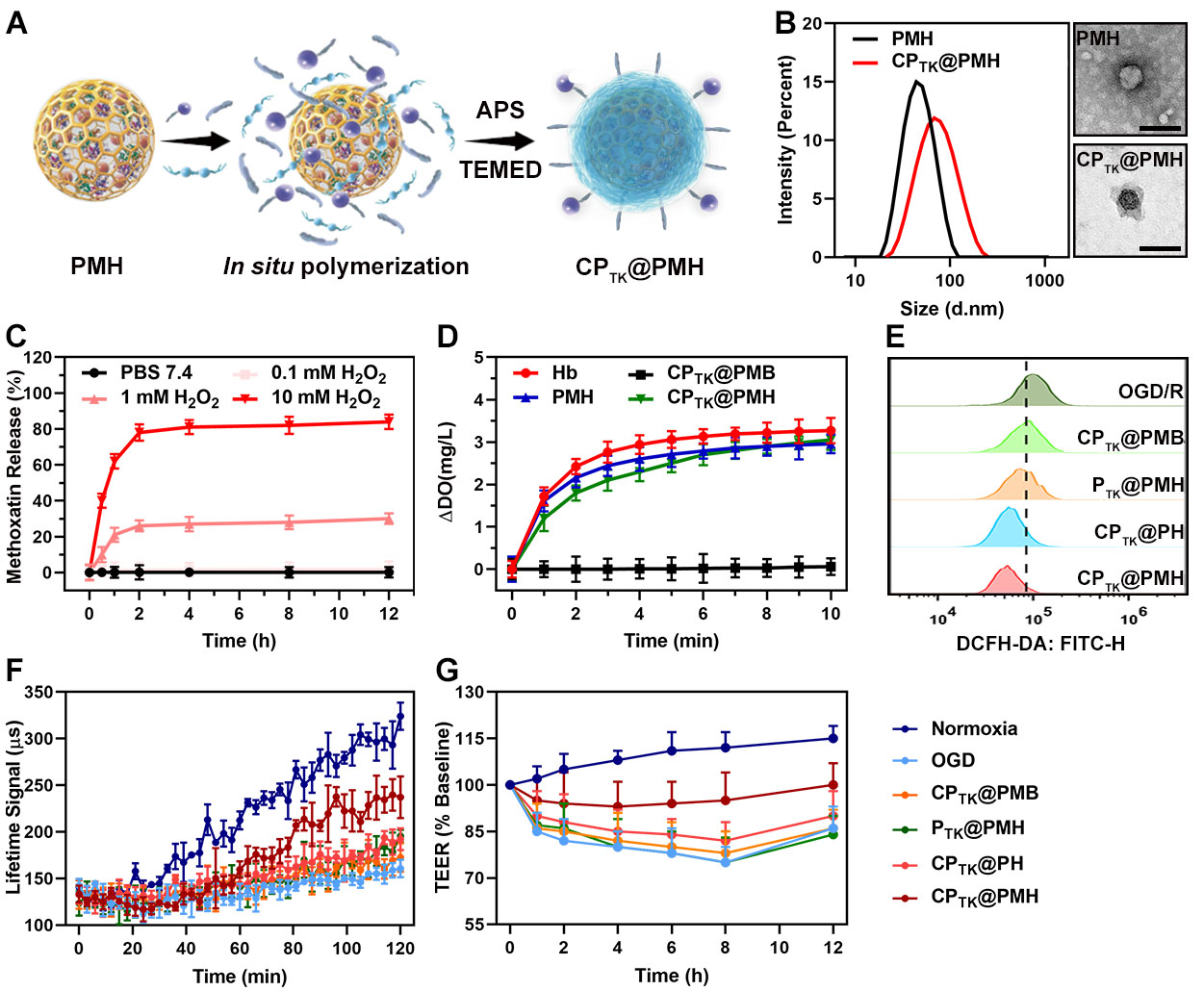Formulation and Delivery - Biomolecular
Category: Late Breaking Poster Abstract
(T0930-12-77) Bioinspired Nanoerythrocytes for Metabolic Microenvironment Remodeling and Long-Term Prognosis Promoting of Acute Ischemic Stroke
Tuesday, October 24, 2023
9:30 AM - 10:30 AM ET
- PL
Peixin Liu, Ph.D.
Fudan University
Shanghai, Shanghai, China (People's Republic) - CJ
Chen Jiang, Ph.D.
Fudan University
Shanghai, Shanghai, China (People's Republic) - TS
Tao Sun, Ph.D.
Fudan University
Shanghai, Shanghai, China (People's Republic)
Presenting Author(s)
Main Author(s)
Co-Author(s)
Purpose: Inspired by the natural hemoglobin (Hb) carrying oxygen mechanism, a polymer-based nanoerythrocyte is designed to remodel the metabolic microenvironment in the whole stages of acute ischemic stroke (AIS). Nanoerythrocyte can actively accumulate in the ischemic core and respond to the metabolic microenvironment. After saturated with oxygen, this nanoerythrocyte can sensitively release oxygen to relieve the hypoxia at ischemic area and inhibit HIF-1α signaling pathway. During the process of reperfusion, excess oxygen can be integrated by nanoerythrocyte to block ROS generation and acute injury caused by pro-inflammatory microenvironment can be alleviated. After stimuli-sensitive cargo release, the energy and glucose metabolism of neurons can be remodeled via Akt/GSK-3β activation, which thereby promote BBB repair and behavioral recovery.
Methods: Photochemically induced occlusion method was applied to create pMCAO model mice. Monofilament method was applied to create tMCAO model mice. IVIS was used to monitor the in vivo fate of nanoerythrocytes. MRI was to real-time measure the infarct size of MCAO model mice brains. PET-CT was used to image the glucose metabolism of tMCAO model mice brains. Tissue clearing was used to display the infarct volume and vessels in the whole brains of tMCAO model mice brains.
Results: The inner core (PMH) was prepared via a oxidative polymerization of dopamine method. The monomers and linker were covalently linked to the surface of PMH core through in situ free-radical polymerization (Figure 2A). PMH showed a hydrodynamic diameter around 62 nm. The particle size of CPTK@PMH was about 23 nm larger than that of PMH and a distinct polymer layer could be observed in TEM images (Figure 2B). Accelerated release behavior of CPTK@PMH nanoerythrocyte appeared in PBS 7.4 containing 1 × 10−2 M H2O2 within 2 h (Figure 2C). The oxygen-carrying capability of free Hb, PMH and CPTK@PMH was found at a similar level within 10 min (Figure 2D). In vitro efficacy evaluation experiments showed the rapid ROS scavenging ability of nanoerythrocyte in SH-SY5Y cells (Figure 2E). Real-time monitoring of oxygen metabolism in OGD treated SH-SY5Y cells demonstrated oxygen consumption of SH-SY5Y cells treated with CPTK@PMH recovered to about half of normal cells (Figure 2F). The change of transepithelial electrical resistance (TEER) was monitored as an indicator of BBB permeability. Results showed that only CPTK@PMH group could keep the TEER around the baseline during OGD/R (Figure 2G). For in vivo evaluation of drug efficacy, photo-chemoembolization was used to observe the changes in hypoxia and thread monofilament was used to observe the degree of reperfusion recovery (Figure 3A and B). A stronger brain fluorescence signal was observed in CPTK@PMH-treated tMCAO mice brains, isolated brains and brain slices at 6 h post-administration compared with P<sub>TK@PMH nanoerythrocyte with low fibrin binding affinity in tMCAO mice and CPTK@PMH-treated Sham mice with no fibrin deposition (Figure 3C). Immunostaining of HIF-1α and hypoxic area labele by hypoxyprobe was applied on brain slices to further demonstrate the improvement of hypoxic microenvironment by CPTK@PMH (Figure 3D). The MRI results indicated the protective effects of CPTK@PMH in reducing infarct areas of tMCAO mouse (Figure 3E) which also be demonstrated by the tissue clearing results shown in Figure 3G. In vivo PET/CT imaging showed that the signal of [18F]FDG, a glucose PET radiotracer, in ischemic brains was recovered after CPTK@PMH treatment (Figure 3F). The angiogenesis effects of CPTK@PMH from a three-dimension perspective as the upregulation of branching and density of blood vessels (Figure 3H). These in vitro and in vivo studies demonstrated the feasibility of CPTK@PMH as a nanomedicine for metabolic modulation in living cells and ischemic brains.
Conclusion: In this work, we have reported a bioinspired nanoerythrocyte for modulating the metabolic microenvironment to promote long-term prognosis of AIS. By targeting microthrombus, nanoerythrocyte could actively reach the lesion of ischemic core and enhance the retention of cargoes. Relief of hypoxia and direct neuroprotection in the ischemia stage were achieved by the delivery and sensitive-release of oxygen. Acute injury in the reperfusion stage was inhibited by ROS scavenging and microglia polarization. Glucose metabolism activation via Akt/GSK-3β signaling pathway and BBB protection was demonstrated in the recovery stage. During these process, key metabolic elements including oxygen balance and glucose metabolism were normalized and satisfactory short-term and long-term therapeutic effects had been obtained in pMCAO and tMCAO mice model respectively. Therefore, this work helps understand the pathological process of different stages of AIS, and indicates that metabolic microenvironment modulation could be integrally targeted as a strategy for AIS treatment. What’s more, the concept of whole stages treatment could realize multiple targets and multiple levels therapy of diseases compared with the recent developed nanomedicines, which might have a better potential for clinical application.
References: Peixin Liu, Tongyu Zhang, Chao Li, Yiwen Zhang, Zheng Zhou, Zhenhao Zhao, Qinjun Chen, Tao Sun, Chen Jiang,
Bioinspired nanoerythrocytes for metabolic microenvironment remodeling and long-term prognosis promoting of acute ischemic stroke,
Nano Today, Volume 49, 2023, 101806, ISSN 1748-0132.
Acknowledgements: We acknowledge the support from the National Natural Science Foundation of China (81872808, 82121002), Key Projects of Shanghai, Science Foundation (19JC1410800), and Shanghai Municipal Science and Technology Major Project (Grant 2018SHZDZX01) and ZJLab.
 Figure 1. Illustration of the CPTK@PMH nanoerythrocyte formation and metabolic microenvironment modulation in ischemic brain: nanoerythrocyte accumulation in ischemic core via microthrombus binding and uptake by neurovascular unit after BBB penetration; (1) hypoxia-responsive oxygen release to relieve necroptosis; (2) oxygen balance regulation to alleviate acute reperfusion injury via oxygen enrichment, ROS scavenging and microglia polarization; (3) repair promotion achieved by metabolic microenvironment modulation via energy and glucose metabolism activation and BBB protection.
Figure 1. Illustration of the CPTK@PMH nanoerythrocyte formation and metabolic microenvironment modulation in ischemic brain: nanoerythrocyte accumulation in ischemic core via microthrombus binding and uptake by neurovascular unit after BBB penetration; (1) hypoxia-responsive oxygen release to relieve necroptosis; (2) oxygen balance regulation to alleviate acute reperfusion injury via oxygen enrichment, ROS scavenging and microglia polarization; (3) repair promotion achieved by metabolic microenvironment modulation via energy and glucose metabolism activation and BBB protection. Figure 2. (A) Illustration of the in-situ polymerization triggered by APS/TEMED in the process of CPTK@PMH formation. (B) Size distribution and TEM images of PMH and CPTK@PMH (scale bar: 100 nm). (C) Methoxatin release profile of CPTK@PMH with or without incubation with different concentration of H2O2 in PBS 7.4 at 37 °C. (D) Monitoring of oxygenconcentration in PBS after adding oxygen pre-saturated Hb, CPTK@PMB, PMH, and CPTK@PMH with an equivalent content of 3 mg/mL Hb or BSA. (E) Flow cytometry analysis of ROS probe fluorescence intensity in OGD/R treated cells. (F) Lifetime profile of Oxygen Consumption Assay (OCR) for OGD treated cells. (G) Relative changes of transepithelial electrical resistance (TER) of bEnd.3 monolayer after 4 h OGD and different times of reoxygenation.
Figure 2. (A) Illustration of the in-situ polymerization triggered by APS/TEMED in the process of CPTK@PMH formation. (B) Size distribution and TEM images of PMH and CPTK@PMH (scale bar: 100 nm). (C) Methoxatin release profile of CPTK@PMH with or without incubation with different concentration of H2O2 in PBS 7.4 at 37 °C. (D) Monitoring of oxygenconcentration in PBS after adding oxygen pre-saturated Hb, CPTK@PMB, PMH, and CPTK@PMH with an equivalent content of 3 mg/mL Hb or BSA. (E) Flow cytometry analysis of ROS probe fluorescence intensity in OGD/R treated cells. (F) Lifetime profile of Oxygen Consumption Assay (OCR) for OGD treated cells. (G) Relative changes of transepithelial electrical resistance (TER) of bEnd.3 monolayer after 4 h OGD and different times of reoxygenation. Figure 3. (A) Illustration of pMCAO mice model establishment. (B) Illustration of tMCAO mice model establishment. (B) Ex vivo IVIS images of major organs 6 h after intravenous injection and representative fluorescence images of brain slices excised after IVIS imaging. (D) Immunostaining of hypoxic markers (scale bar: 4 mm). (E) The infarct area of tMCAO mice treated with different formulations, monitored by MRI at 24 h post reperfusion (scale bar: 4 mm). (F) Representative [18F]FDG PET/CT images of tMCAO model mice brains (scale bar: 4 mm). (G) Whole-brain NeuN imaging with tissue clearing and tracing of lesion area (scale bar: 5 mm). (H) Tissue clearing results of vessel (Lectin staining) in tMCAO model mice whole brains (scale bar: 5 mm).
Figure 3. (A) Illustration of pMCAO mice model establishment. (B) Illustration of tMCAO mice model establishment. (B) Ex vivo IVIS images of major organs 6 h after intravenous injection and representative fluorescence images of brain slices excised after IVIS imaging. (D) Immunostaining of hypoxic markers (scale bar: 4 mm). (E) The infarct area of tMCAO mice treated with different formulations, monitored by MRI at 24 h post reperfusion (scale bar: 4 mm). (F) Representative [18F]FDG PET/CT images of tMCAO model mice brains (scale bar: 4 mm). (G) Whole-brain NeuN imaging with tissue clearing and tracing of lesion area (scale bar: 5 mm). (H) Tissue clearing results of vessel (Lectin staining) in tMCAO model mice whole brains (scale bar: 5 mm).